wheel TOYOTA FJ CRUISER 2010 1.G Service Manual
[x] Cancel search | Manufacturer: TOYOTA, Model Year: 2010, Model line: FJ CRUISER, Model: TOYOTA FJ CRUISER 2010 1.GPages: 439, PDF Size: 11.02 MB
Page 126 of 439
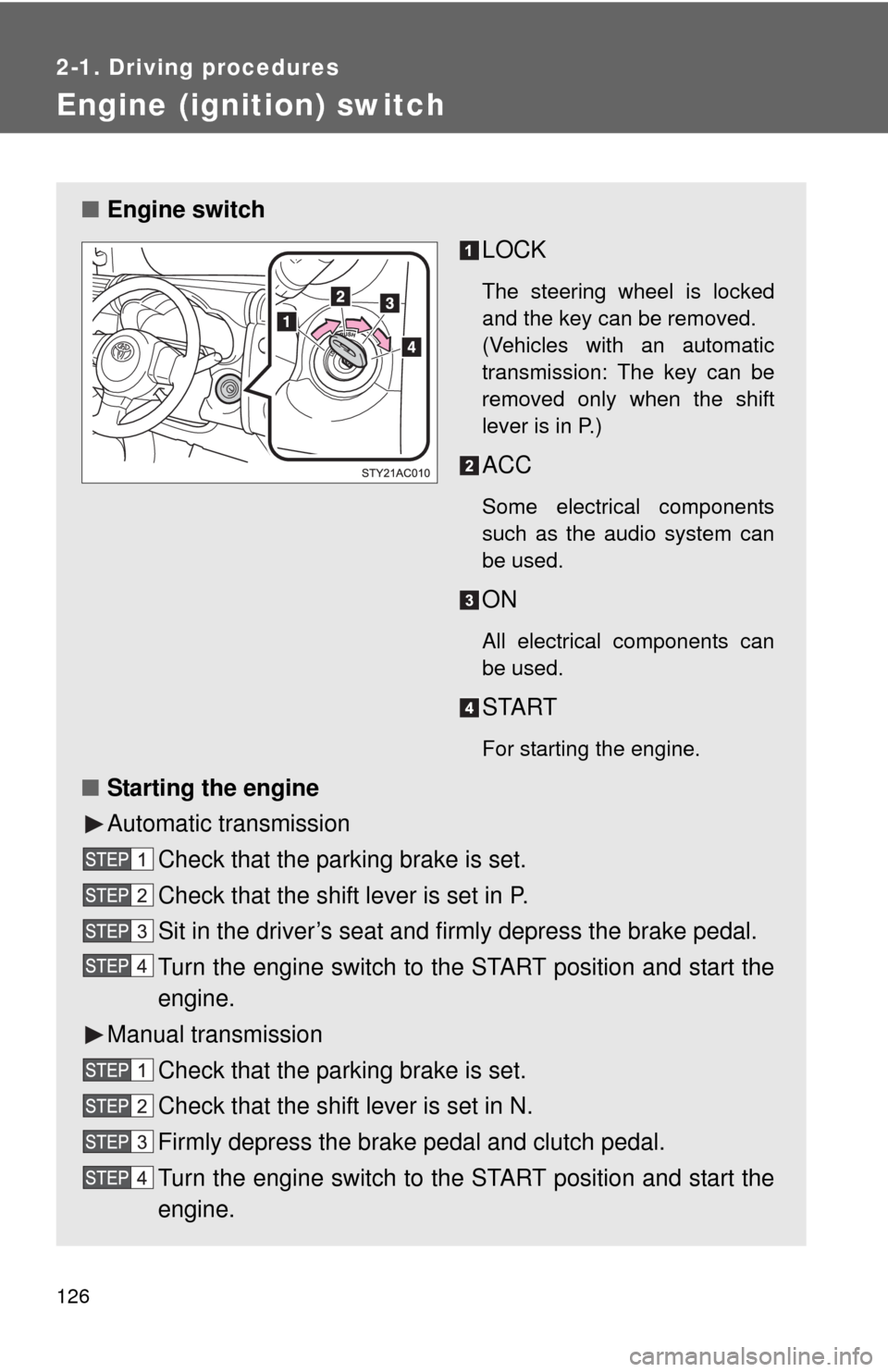
126
2-1. Driving procedures
Engine (ignition) switch
■Engine switch
LOCK
The steering wheel is locked
and the key can be removed.
(Vehicles with an automatic
transmission: The key can be
removed only when the shift
lever is in P.)
ACC
Some electrical components
such as the audio system can
be used.
ON
All electrical components can
be used.
START
For starting the engine.
■Starting the engine
Automatic transmission
Check that the parking brake is set.
Check that the shift lever is set in P.
Sit in the driver’s seat and firmly depress the brake pedal.
Turn the engine switch to the START position and start the
engine.
Manual transmission
Check that the parking brake is set.
Check that the shift lever is set in N.
Firmly depress the brake pedal and clutch pedal.
Turn the engine switch to the START position and start the
engine.
Page 127 of 439
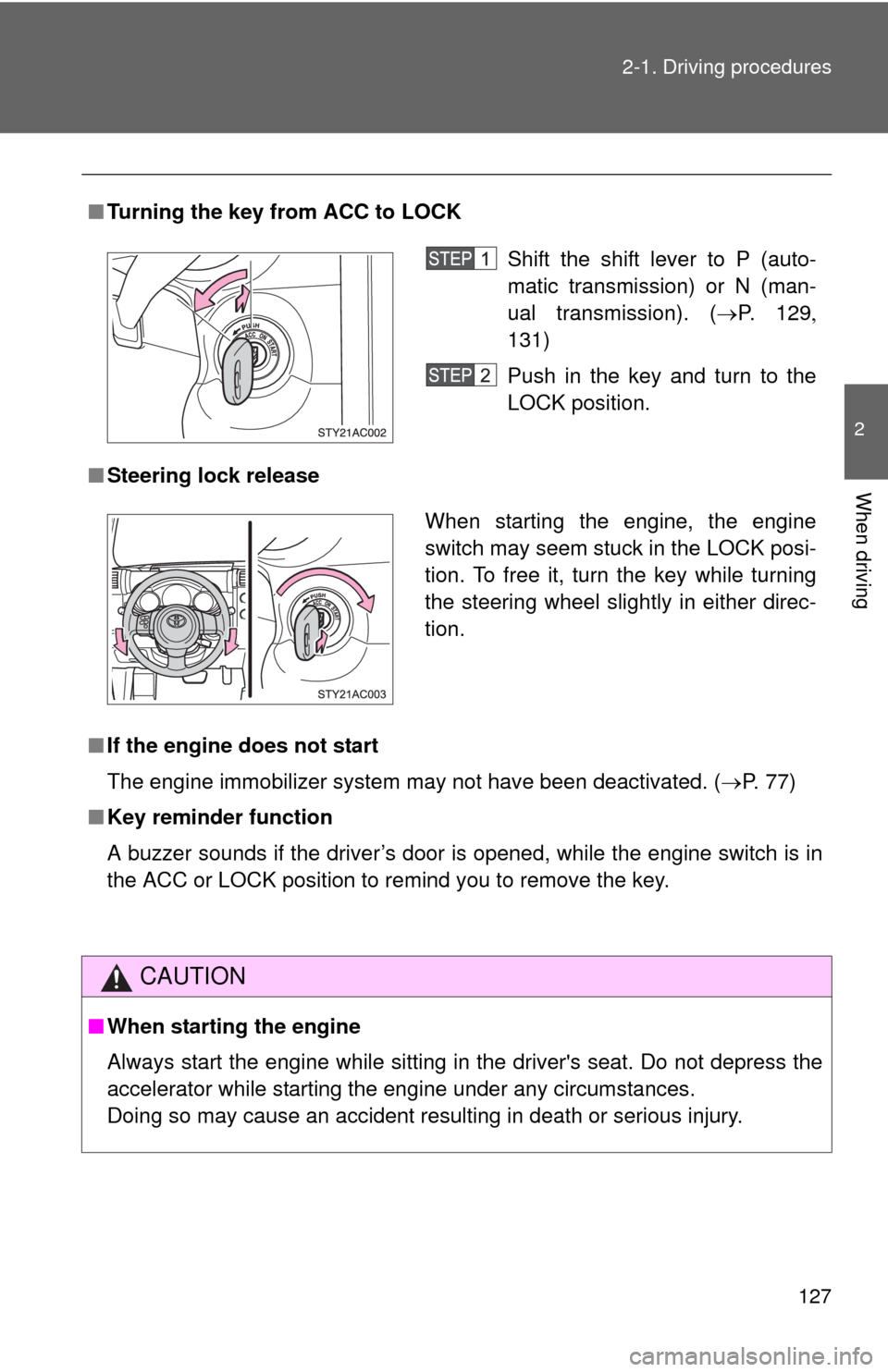
127 2-1. Driving procedures
2
When driving
■Turning the key from ACC to LOCK
■Steering lock release
■If the engine does not start
The engine immobilizer system may not have been deactivated. (P. 77)
■Key reminder function
A buzzer sounds if the driver’s door is opened, while the engine switch is in
the ACC or LOCK position to remind you to remove the key.
CAUTION
■When starting the engine
Always start the engine while sitting in the driver's seat. Do not depress the
accelerator while starting the engine under any circumstances.
Doing so may cause an accident resulting in death or serious injury.
Shift the shift lever to P (auto-
matic transmission) or N (man-
ual transmission). (P. 129
131)
Push in the key and turn to the
LOCK position.
When starting the engine, the engine
switch may seem stuck in the LOCK posi-
tion. To free it, turn the key while turning
the steering wheel slightly in either direc-
tion.
Page 136 of 439
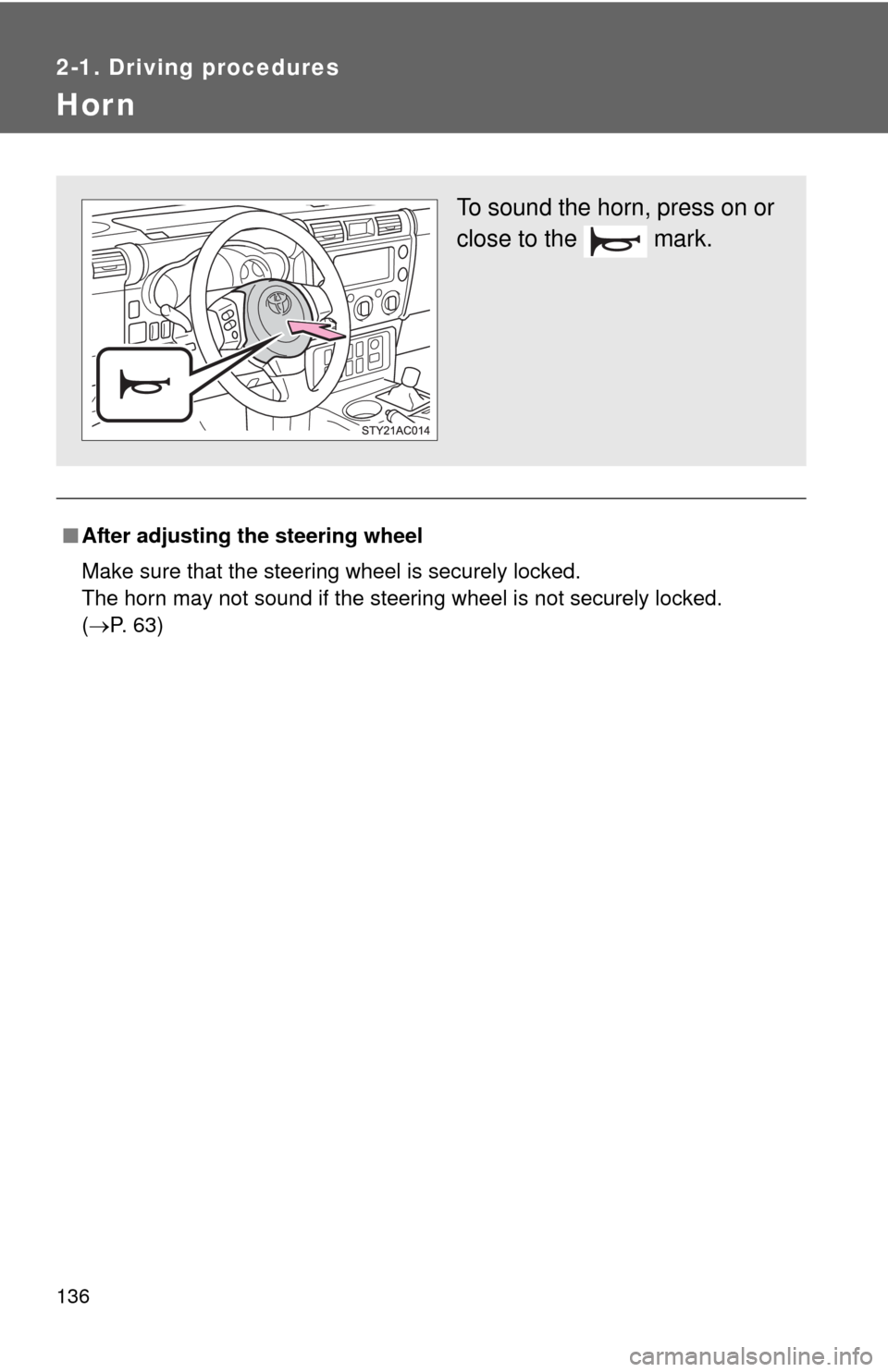
136
2-1. Driving procedures
Hor n
■After adjusting the steering wheel
Make sure that the steering wheel is securely locked.
The horn may not sound if the steering wheel is not securely locked.
(P. 63)
To sound the horn, press on or
close to the mark.
Page 141 of 439
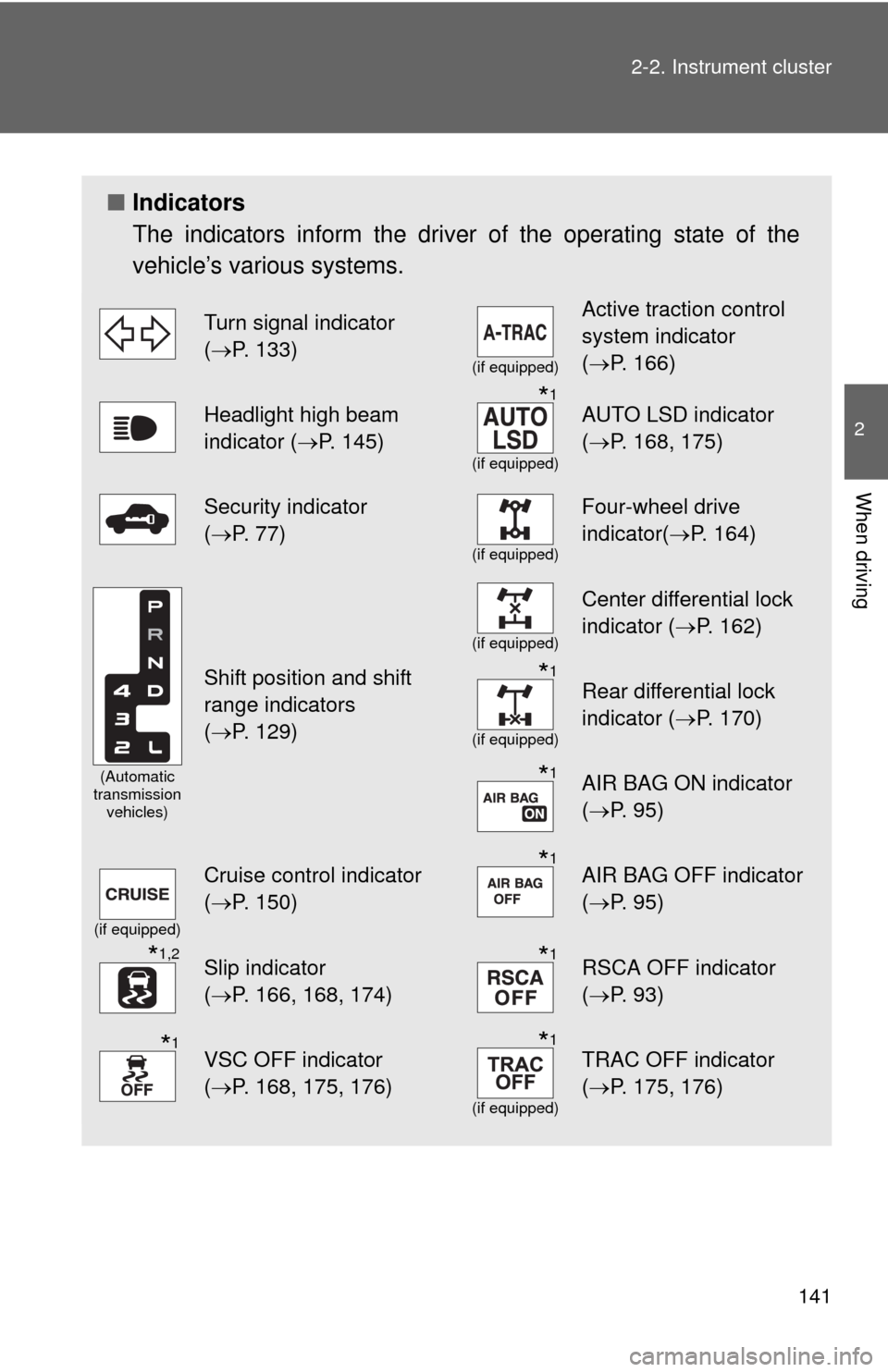
141 2-2. Instrument cluster
2
When driving
■Indicators
The indicators inform the driver of the operating state of the
vehicle’s various systems.
Turn signal indicator
(P. 133)
(if equipped)
Active traction control
system indicator
(P. 166)
Headlight high beam
indicator (P. 145)*1
(if equipped)
AUTO LSD indicator
(P. 168, 175)
Security indicator
(P. 77)
(if equipped)
Four-wheel drive
indicator(P. 164)
(Automatic
transmission
vehicles)
Shift position and shift
range indicators
(P. 129)
(if equipped)
Center differential lock
indicator (P. 162)
*1
(if equipped)
Rear differential lock
indicator (P. 170)
*1AIR BAG ON indicator
(P. 95)
(if equipped)
Cruise control indicator
(P. 150)*1AIR BAG OFF indicator
(P. 95)
*1,2Slip indicator
(P. 166, 168, 174)*1RSCA OFF indicator
(P. 93)
*1VSC OFF indicator
(P. 168, 175, 176)*1
(if equipped)
TRAC OFF indicator
(P. 175, 176)
Page 162 of 439
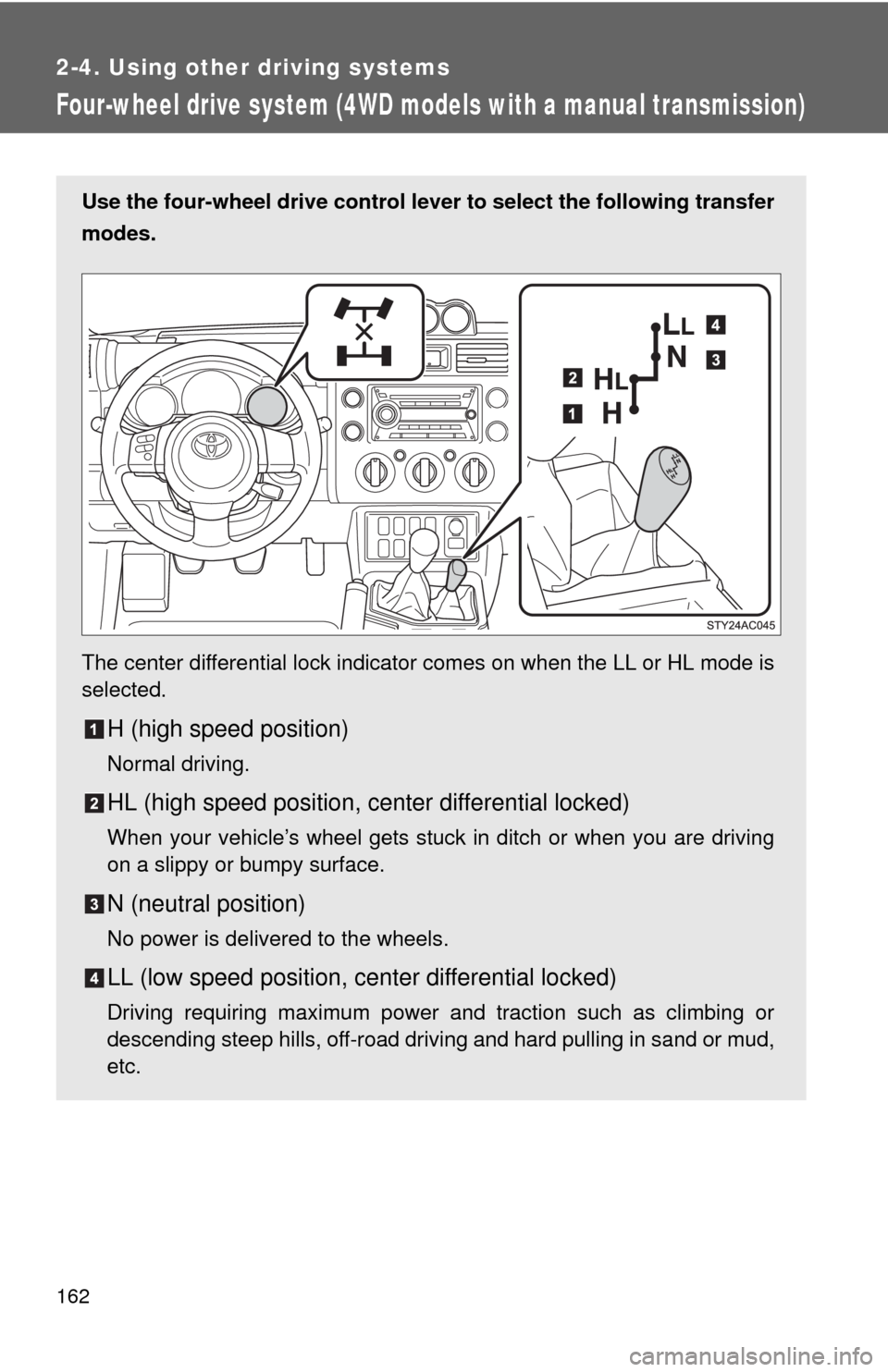
162
2-4. Using other driving systems
Four-wheel drive system (4WD models with a manual transmission)
Use the four-wheel drive control lever to select the following transfer
modes.
The center differential lock indicator comes on when the LL or HL mode is
selected.
H (high speed position)
Normal driving.
HL (high speed position, center differential locked)
When your vehicle’s wheel gets stuck in ditch or when you are driving
on a slippy or bumpy surface.
N (neutral position)
No power is delivered to the wheels.
LL (low speed position, center differential locked)
Driving requiring maximum power and traction such as climbing or
descending steep hills, off-road driving and hard pulling in sand or mud,
etc.
Page 163 of 439

163 2-4. Using other driving systems
2
When driving
■Shifting between H and HL
●You need not to depress the clutch pedal.
●If the center differential lock indicator does not come on when you shift
from H to HL, drive straight ahead while accelerating or decelerating.
●If the center differential lock indicator does not go off when you shift from
HL to H, drive straight ahead while accelerating or decelerating, or drive
in reverse.
■Shifting from HL to LL
Stop the vehicle or reduce your speed to less than 5 mph (8 km/h).
Depress the clutch pedal and move the four-wheel drive control lever.
■Shifting from LL to HL
Depress the clutch pedal and move the four-wheel drive control lever.
■Shifting to LL
VSC is automatically turned off.
NOTICE
■To prevent damage to the center differential
●For normal driving on dry and hard surface roads, unlock the center differ-
ential.
●Shift to H after the wheels are out of the ditch or off the slippery or bumpy
surface.
●Do not shift to any position when the vehicle is cornering or when its
wheels spinning freely off the ground.
■Shifting from H to HL while driving
Never operate the four-wheel drive control lever if the wheels are slipping.
Stop the slipping or spinning before shifting.
Page 164 of 439
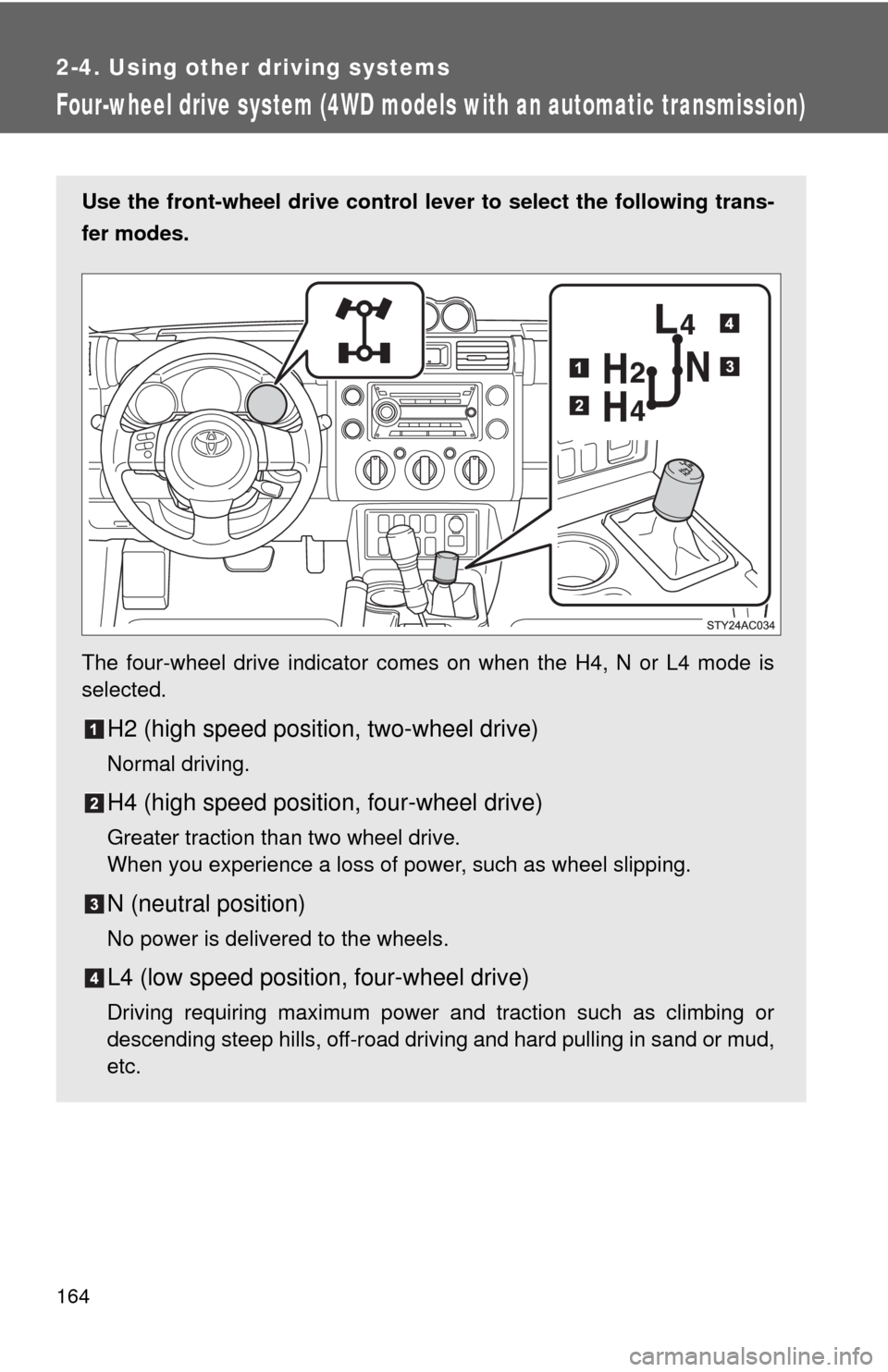
164
2-4. Using other driving systems
Four-wheel drive system (4WD models with an automatic transmission)
Use the front-wheel drive control lever to select the following trans-
fer modes.
The four-wheel drive indicator comes on when the H4, N or L4 mode is
selected.
H2 (high speed position, two-wheel drive)
Normal driving.
H4 (high speed position, four-wheel drive)
Greater traction than two wheel drive.
When you experience a loss of power, such as wheel slipping.
N (neutral position)
No power is delivered to the wheels.
L4 (low speed position, four-wheel drive)
Driving requiring maximum power and traction such as climbing or
descending steep hills, off-road driving and hard pulling in sand or mud,
etc.
Page 165 of 439
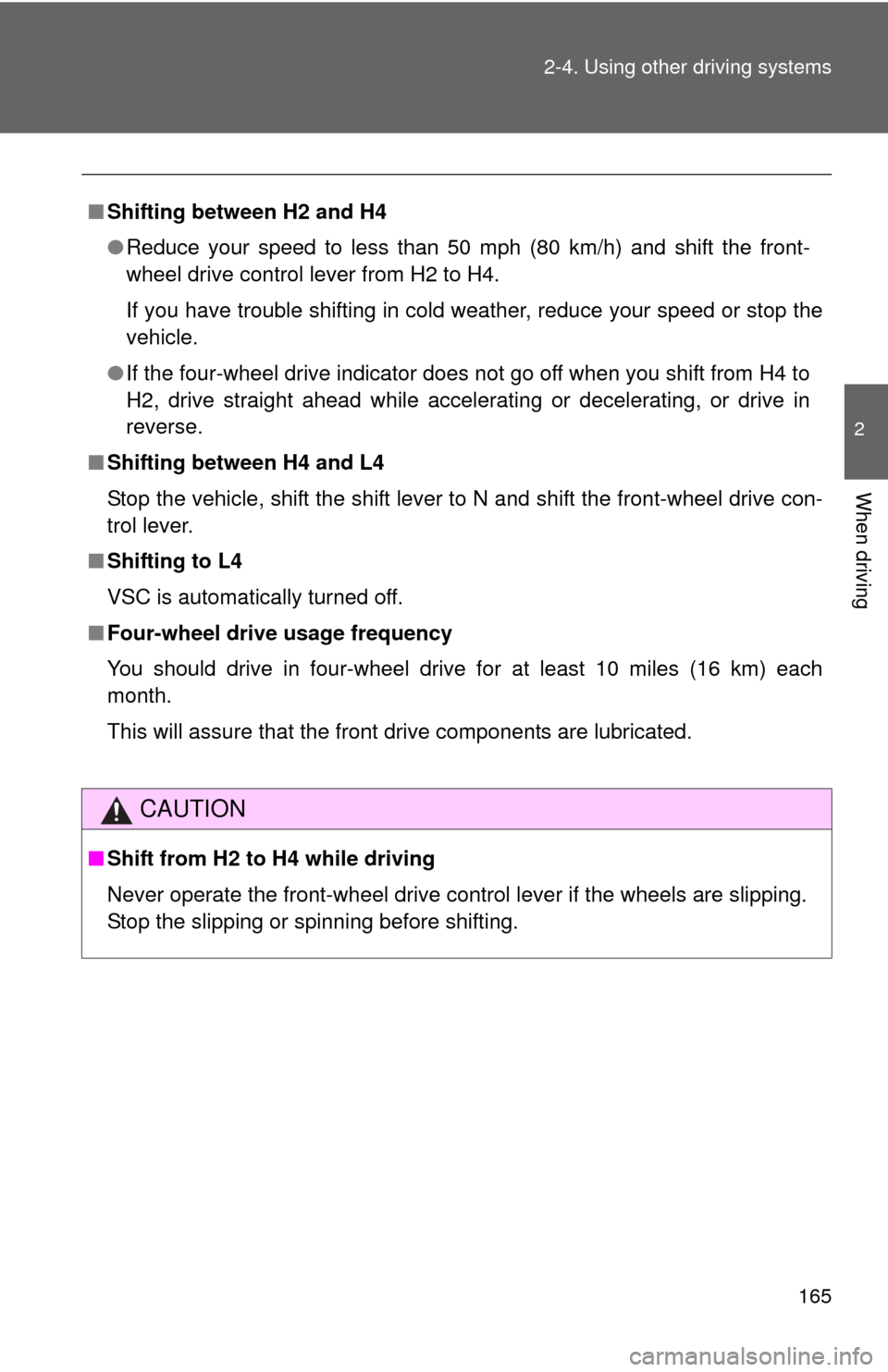
165 2-4. Using other driving systems
2
When driving
■Shifting between H2 and H4
●Reduce your speed to less than 50 mph (80 km/h) and shift the front-
wheel drive control lever from H2 to H4.
If you have trouble shifting in cold weather, reduce your speed or stop the
vehicle.
●If the four-wheel drive indicator does not go off when you shift from H4 to
H2, drive straight ahead while accelerating or decelerating, or drive in
reverse.
■Shifting between H4 and L4
Stop the vehicle, shift the shift lever to N and shift the front-wheel drive con-
trol lever.
■Shifting to L4
VSC is automatically turned off.
■Four-wheel drive usage frequency
You should drive in four-wheel drive for at least 10 miles (16 km) each
month.
This will assure that the front drive components are lubricated.
CAUTION
■Shift from H2 to H4 while driving
Never operate the front-wheel drive control lever if the wheels are slipping.
Stop the slipping or spinning before shifting.
Page 166 of 439
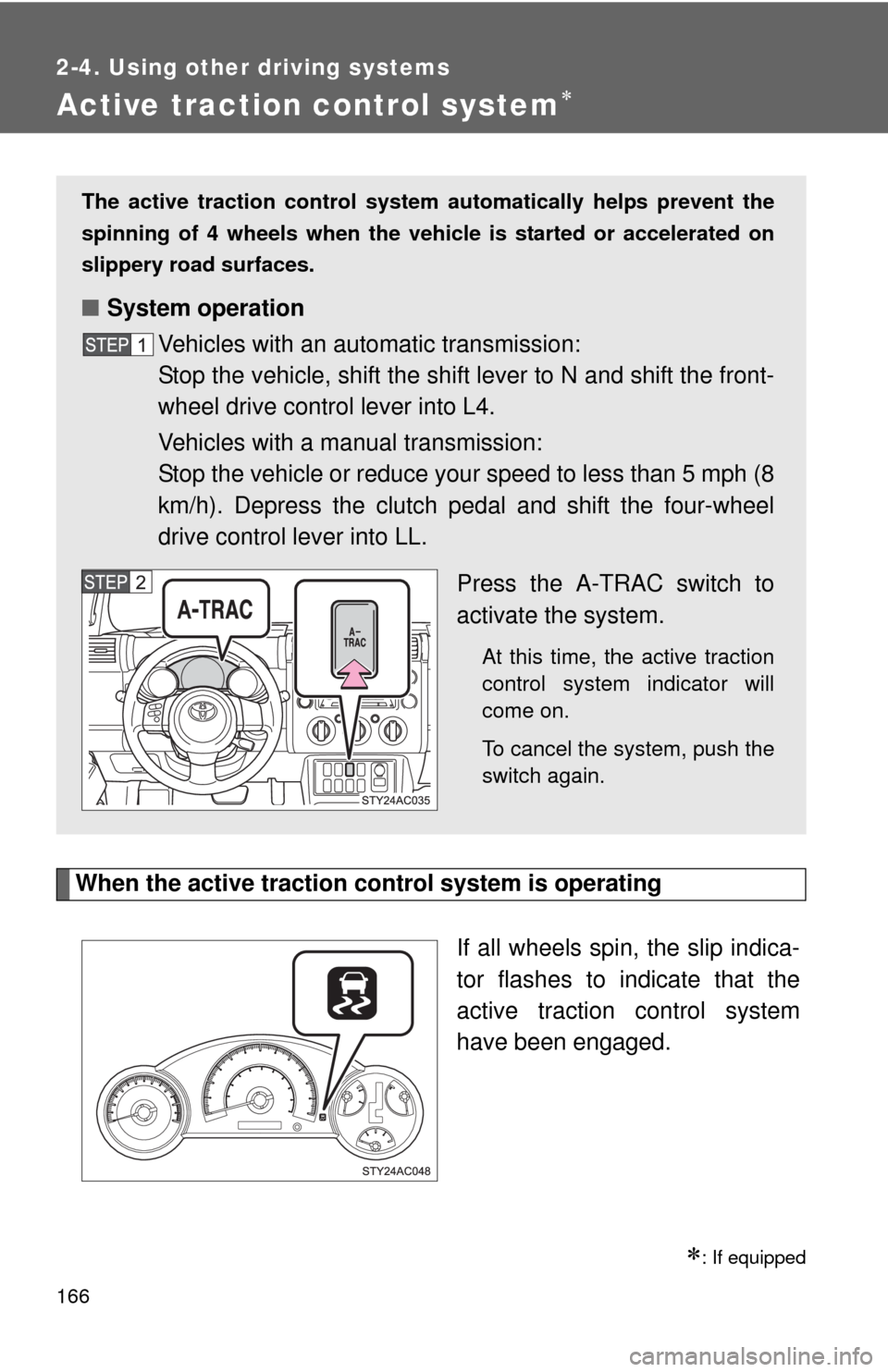
166
2-4. Using other driving systems
Active traction control system
When the active traction control system is operating
If all wheels spin, the slip indica-
tor flashes to indicate that the
active traction control system
have been engaged.
: If equipped
The active traction control system automatically helps prevent the
spinning of 4 wheels when the vehicle is started or accelerated on
slippery road surfaces.
■System operation
Vehicles with an automatic transmission:
Stop the vehicle, shift the shift lever to N and shift the front-
wheel drive control lever into L4.
Vehicles with a manual transmission:
Stop the vehicle or reduce your speed to less than 5 mph (8
km/h). Depress the clutch pedal and shift the four-wheel
drive control lever into LL.
Press the A-TRAC switch to
activate the system.
At this time, the active traction
control system indicator will
come on.
To cancel the system, push the
switch again.
Page 168 of 439
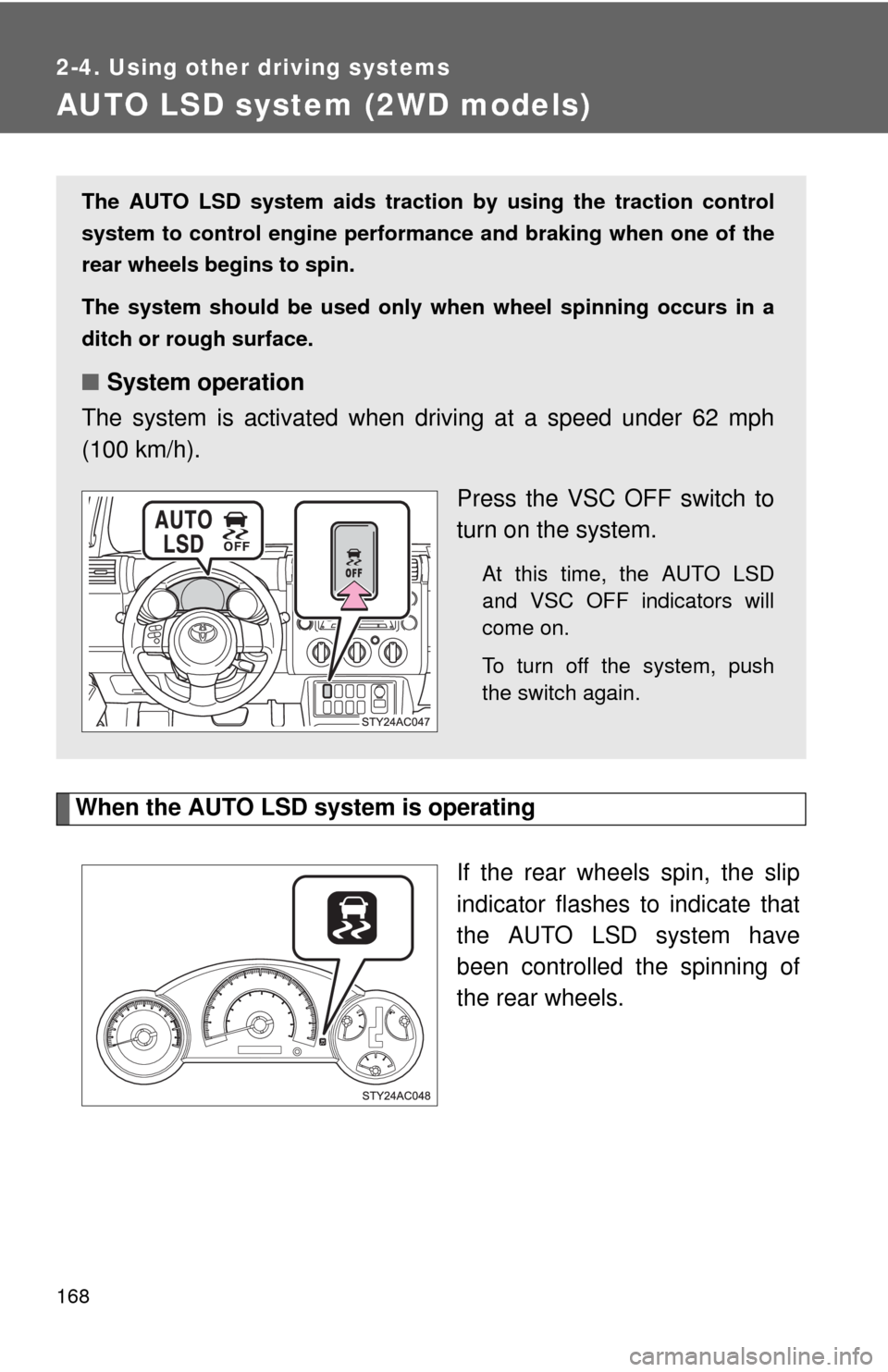
168
2-4. Using other driving systems
AUTO LSD system (2WD models)
When the AUTO LSD system is operating
If the rear wheels spin, the slip
indicator flashes to indicate that
the AUTO LSD system have
been controlled the spinning of
the rear wheels.
The AUTO LSD system aids traction by using the traction control
system to control engine performance and braking when one of the
rear wheels begins to spin.
The system should be used only when wheel spinning occurs in a
ditch or rough surface.
■System operation
The system is activated when driving at a speed under 62 mph
(100 km/h).
Press the VSC OFF switch to
turn on the system.
At this time, the AUTO LSD
and VSC OFF indicators will
come on.
To turn off the system, push
the switch again.